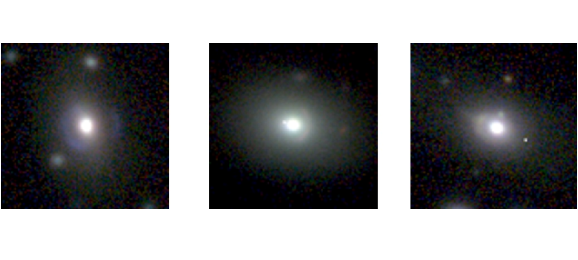Kunstmatige Intelligentie vindt 56 Nieuwe Kandidaat-Zwaartekrachtlenzen

Een groep astronomen van de universiteiten van Groningen, Napels en Bonn heeft een methode ontwikkeld die automatisch zeldzame zwaartekrachtlenzen vindt in enorme databestanden van waarnemingen. De methode is gebaseerd op hetzelfde algoritme voor kunstmatige intelligentie dat Google, Facebook en Tesla gebruiken. De onderzoekers publiceren hun methode en 56 nieuwe zwaartekrachtlenskandidaten in het novembernummer van Monthly Notices of the Royal Astronomical Society.
Als een sterrenstelsel achter een ander sterrenstelsel verborgen ligt, is het verborgen stelsel soms toch zichtbaar rond het voorste stelsel. Dit heet een zwaartekrachtlens, omdat het wordt voorspeld door de algemene relativiteitstheorie van Einstein die zegt dat massa licht kan afbuigen. Astronomen speuren naar zwaartekrachtlenzen, omdat ze helpen in het onderzoek naar donkere materie.
De jacht op zwaartekrachtlenzen is monnikenwerk. Astronomen moeten duizenden afbeeldingen van de hemel bekijken. Ze worden hierbij geholpen door enthousiaste vrijwilligers over de hele wereld. Tot nu toe liep de zoektocht nog wel in de pas met het beschikbaar komen van nieuwe afbeeldingen. Maar dankzij nieuwe waarnemingen met speciale telescopen die grote stukken van de hemel afspeuren, komen er miljoenen afbeeldingen bij. Dat is voor mensen niet meer bij te houden.
Om de stroom aan afbeeldingen te lijf te gaan, hebben de sterrenkundigen zogeheten 'convolutional neural networks' gebruikt. Google heeft deze neurale netwerken ingezet om het spel Go te winnen tegen de wereldkampioen. Facebook gebruikt ze voor het herkennen van de beelden op je tijdlijn. En Tesla ontwikkelt zelfrijdende auto's met behulp van deze neurale netwerken.
De sterrenkundigen trainden het neurale netwerk met behulp van miljoenen zelfgemaakte afbeeldingen van zwaartekrachtlenzen. Daarna lieten ze het netwerk los op miljoenen afbeeldingen van een stukje sterrenhemel met een oppervlak van 255 vierkante graden. Dat is iets meer dan een half procent van het hemeloppervlak.
Het neurale netwerk vond in eerste instantie 761 nieuwe kandidaat-zwaartekrachtlenzen. Dat werden er, na handmatige schifting door de sterrenkundigen, uiteindelijk 56. Die 56 lenzen moeten nog definitief worden bevestigd met een waarneming door telescopen als de Hubble-ruimtetelescoop.
Daarnaast herontdekte het neurale netwerk twee bekende lenzen. Helaas zag het een derde, bekende lens over het hoofd. Dat is een kleine lens en daarop was het neurale netwerk nog niet getraind.
In de toekomst willen de onderzoekers hun neurale netwerk nog beter trainen zodat het minder foute lenzen vindt en de kleine ook opmerkt. Het uiteindelijke doel is om lenzen op te sporen zonder menselijke, visuele inspectie.
Carlo Enrico Petrillo (Rijksuniversiteit Groningen), eerste auteur van de wetenschappelijk publicatie: "Dit is de eerste keer dat een convolutional neural network gebruikt is om uitzonderlijke objecten uit een hemelsurvey te filteren. Ik denk dat kunstmatige intelligentie in de toekomst de norm wordt omdat de surveys gigantische hoeveelheden gegevens opleveren en we gewoon niet genoeg astronomen hebben om alle gegevens door te spitten."
De gegevens die het neuronale netwerk verwerkte, komen van deKilo-Degree Survey. Dat project gebruikt deVLT Survey Telescopevan de Europese Zuidelijke Sterrenwacht (ESO) op de berg Paranal (Chili). De bijbehorende panoramische camera, OmegaCAM, is ontwikkeld onder Nederlandse leiding.
Lees verder op Astronomie.nl

